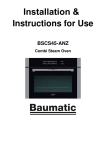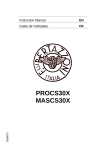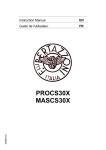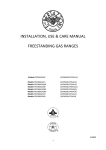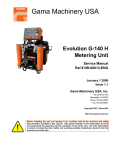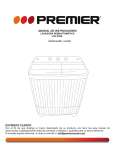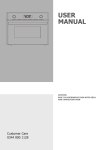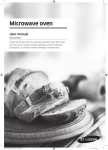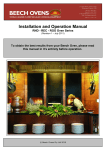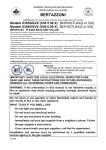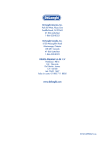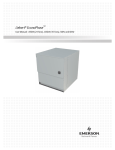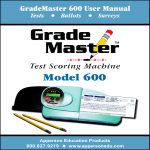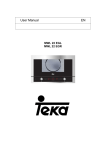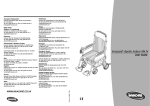Download User Guide
Transcript
Instruction Manual EN Guide de l'utilisateur FR 1630873 PROCS30X MASCS30X EN Contents Grounding Instructions ...................................................................................................................... 2 Safety Information .............................................................................................................................. 3 Safety Instructions ............................................................................................................................. 5 Description of your oven.................................................................................................................... 6 Basic settings ..................................................................................................................................... 8 Basic Functions ................................................................................................................................ 10 Special Functions ............................................................................................................................. 13 Filling the water tank ........................................................................................................................ 14 When the oven is working................................................................................................................ 15 Usage, Tables and Tips .................................................................................................................... 16 Cooking with the Broiler .................................................................................................................. 21 Cooking with Convection ................................................................................................................. 23 Care and maintenance ..................................................................................................................... 24 Oven Cleaning ................................................................................................................................... 27 What should I do if the oven doesn’t work? ................................................................................... 28 Technical characteristics ................................................................................................................. 29 Installation instructions ................................................................................................................... 30 Installation dimensions .................................................................................................................... 66 Dear Customer, Before going any further, we want to thank you for preferring our BERTAZZONI product. We are sure that this modern, functional and practical steam oven, manufactured with top quality materials, will fully meet your expectations. We ask you to read the instructions in this booklet very carefully as this will allow you to get the best results from using your steam oven. KEEP THE DOCUMENTATION OF THIS PRODUCT FOR FUTURE REFERENCE. Always keep the instruction manual handy. If you lend the steam oven to someone else give them the manual as well! The user manual is also available for download at www.bertazzoni.com 1 Grounding Instructions EN This appliance must be connected to a grounded, metallic, permanent wiring system, or an equipment grounding conductor should be run with the circuit conductors and connected to the equipment grounding terminal or lead on the appliance. Warning! IMPROPER USE OF THE GROUNDING CAN RESULT IN A RISK OF ELECTRICAL SHOCK. Please refer to the Installation Instructions for further information. 2 EN Safety Information Carefully read the instructions before installing and using the equipment. The manufacturer is not liable for improper installation and use of the equipment that may cause injuries and damage. Always keep the instructions at hand, so they can be easily referred to during use. IMPORTANT SAFEGUARDS When using electrical appliances, basic safety precautions should always be followed including the following: 1. Proper Installation – Be sure your appliance is properly installed and grounded by a qualified technician. 2. Never Use Your Appliance for Warming or Heating the Room. 3. Do Not Leave Children Alone – Children should not be left alone or unattended in area where appliance is in use. They should never be allowed to sit or stand on any part of the appliance. 4. Wear Proper Apparel – Loose-fitting or hanging garments should never be worn while using the appliance. 5. User Servicing – Do not repair or replace any part of the appliance unless specifically recommended in the manual. All other servicing should be referred to a qualified technician. 6. Storage in or on Appliance – Flammable materials should not be stored in an oven 7. Do Not Use Water on Grease Fires – Smother fire or flame or use dry chemical or foam-type extinguisher. 8. Use Only Dry Potholders – Moist or damp potholders on hot surfaces may result in burns from steam. Do not let potholder touch hot heating elements. Do not use a towel or other bulky cloth. 9. Use Care When Opening Door – Let hot air or steam escape before removing or replacing food. 10. Do Not Heat Unopened Food Containers – Build-up of pressure may cause container to burst and result in injury. 11. Keep Oven Vent Ducts Unobstructed. 12. Placement of Oven Racks – Always place oven racks in desired location while oven is cool. If rack must be moved while oven is hot, do not let potholder contact hot heating element in oven. 13. DO NOT TOUCH HEATING ELEMENTS OR INTERIOR SURFACES OF OVEN – Heating elements may be hot even though they are dark in color. Interior surfaces of an oven become hot enough to cause burns. During and after use, do not touch, or let clothing or other flammable materials contact heating elements or interior surfaces of oven until they have had sufficient time to cool. This Steam Oven is for household use. 3 Safety Information EN Safety of children and vulnerable adults WARNING! Risk of choking, injury or permanent disability. This appliance can be used by children aged 8 years and above and persons with reduced physical, sensory or mental capabilities or lack of experience and knowledge if they are given supervision or instructions concerning how to use the appliance in a safe way and understand the hazards involved. Children should not play with the appliance. Keep packaging materials away from children. Risk of suffocation! Keep children away from the appliance during operation or when cooling. Cleaning and maintenance should not be done by children without supervision. Warnings on general safety During installation, follow the instructions supplied separately. Only qualified personnel can install the appliance and replace the cable. WARNING: The appliance and its accessible parts become hot during use. Care should be taken to avoid touching heating elements. Children less than 8 years of age shall be kept away unless continuously supervised. During use the appliance becomes hot. Care should be taken to avoid touching heating elements inside the oven. WARNING: Accessible parts may become hot during use. Young children should be kept away. Do not use steam cleaners to clean the appliance. Do not use abrasive detergents or metal scrapers to clean the appliance. The electric connection is made via an omnipolar switch, which is suitable for the intensity to be tolerated and which has a minimum gap of 3mm between its contacts, which will ensure disconnection in case of emergency or when cleaning the crockery warmer. If a plug is used for the electric connection, then it must be accessible after installation. The connection should include correct earthing, in compliance with current norms. Disconnect the appliance from the power supply before carrying out any maintenance operation. 4 EN Safety Instructions WARNING! Before connecting the appliance compare the power data (voltage and frequency) indicated on the characteristics plate with those of the power supply in question. If these data do not match there may be problems. In case of doubt, contact an electrician. WARNING! If the electrical wire plug is removed, the appliance must be installed and connected by a technician. Contact a qualified electrician who knows and respects current safety standards. The manufacturer cannot be held responsible for damage resulting from fitting or connecting errors. WARNING! The electrical safety of the appliance can only be guaranteed if it is earthed. The manufacturer cannot be held responsible for damage resulting from the absence of or defects in the installation’s protection system (e.g. electrical shock). WARNING! Only use the appliance once it has been fitted into its built-in position. Only in this manner can it be guaranteed that users cannot access the electrical components. WARNING! Never open up the appliance’s frame. Possible contacts with electrical conducting parts or changes to electrical or mechanical components 5 may represent a danger to users’ safety and prejudice the correct working of the appliance. WARNING! Repairs and maintenance, especially of parts carrying electrical current, must only be done by technicians authorised by the manufacturer. The manufacturer and retailers do not accept responsibility for any damaged caused to people, animals or property as a result of repairs and maintenance carried out by non-authorised personnel. WARNING! Repairs undertaken during the guarantee period must only be done by technicians authorised by the manufacturer. If this is not the case then any damage resulting from the repair in question is excluded from the guarantee WARNING! The appliance must be disconnected from the electrical current when installation and repair work is being done. To disconnect the appliance from the current, one of the following conditions must apply: • The switchboard fuses / circuit breakers must be disconnected. • The plug should be removed from the socket. To remove the plug from the socket do not pull on the electric cable but rather pull out the plug itself directly. EN Description of your oven 1. – Door window glass 2. – Safety catches 3. – Water tank 4. – Control panel 1. 2. 3. 4. 5. 6. 7. 8. Function Selector knob “+” / “-“ Selector knob Display “-“ key “+“ key OK key Start key 5. – Baking tray 6. – Perforated baking tray 7. – Shelf guides 8. – Rack 9. – Lamp bulb a. b. c. d. e. f. Delayed Start indicator Descale indicator Clock indicator Safety Block indicator Operating Time / Duration indicator Temperature indicator Stop key 6 EN Description of your oven Description of Functions Symbol Function Foods / Function Steam Cooking vegetables and food. Cooking and heating carefully. Heating and cooking small portions of food. Broiler Broiling food. Convection Roasting and baking. Steam + Convection Cooking meals with hot damp circulating air. Cooking potatoes, rice. Moist garnishing. Broiling meat and fish. Broiler + Fan Broiling poultry. Potatoes – deep frozen, defrosting and roasting. Water Hardness / Descaling 7 Water Hardness setting / Descaling function EN Basic settings Initial Settings After your steam oven is first plugged in or after a power failure, the clock display will flash to indicate that the time shown is not correct. To set the clock and the water hardness parameter value proceed as described in the following chapters: The oven will not operate until the clock, the water hardness parameter and the Calibration is set. Setting the clock Before using the oven, adjust the clock through the procedure described below but starting on Step 3. To set the clock, proceed as follows: 1. Press the “+” key until the Clock Indicator Light starts to flash. 4. Press the OK key to validate the hour value. The minute numbers will start to flash. 2. Press the OK key. 5. Turn the “+”/ “-“ Selector Knob to the left or right to set the correct minute value. 3. Turn the “+”/ “-“ Selector Knob to the left or right to set the correct hour value. 6. To finish, press the OK key again. Water Hardness setting The system can be optimised for households with very soft water (also through using a water softening appliance) and very hard water, by changing the user settings to the relevant range of water hardness (see table below). To set the water hardness parameter, proceed as follows: (The appliance features a system that automatically indicates when it is time to descale, showing the message “”.) 1. Rotate the Function Selector knob to the position corresponding to the Water Hardness Setting / Descaling function (not necessary after connecting the device to the network, or after a power failure).The water hardness indicator light begins to flash. 2. Turn the “+” / “-“ Selector Knob to set the correct water hardness parameter value, according to the below table. 3. Press the OK key to set the parameter (or wait until the parameter is set by time-out). The clock is displayed. 8 EN Basic settings Water hardness English deg. French deg. [°eH] [°dF] Type Ca + Mg (ppm) German deg. [°dH] Display Soft water 0 to 150 0 to 11 0 to 15 0 to 8 SOFT Medium water 151 to 350 12 to 25 16 to 35 9 to 20 MED Hard water 501 to 500 26 to 35 36 to 50 21 to 28 HARD Child Lock The oven can be blocked against improper use (e.g., to prevent children from using it). 1. To block, the oven press the Stop key for 3 seconds. The display shows the Safety Block indicator light. If a key is pressed now, the the oven will not operate. 2. To unlock, press again the Stop key for 3 seconds. Showroom mode In the Showroom mode the oven works like described in every function, but there will be no heating. 1 1. To enter the Showroom mode press simultaneously the “-“ key and the Stop key for 5 seconds. The display shows the messages “” and “” intermittently (showing the actual status). 9 3 1 2 2. Turn the “+”/ “-“ Selector Knob to the left or right to alternate status (“” or “”). 3. Press the OK key to validate. Note: To exit the Showroom mode proceed in the same manner. Basic Functions EN Steam function Use this function to cook all sorts of vegetables, rice, fish and meat. It is also suitable for extracting juice from berries and for simultaneous defrosting, cooking and regenerating. 1. Rotate the Function Selector knob to the position corresponding to the Steam function. The Temperature indicator and the display flash indicating “210ºF” (by default). 2. Turn the “+”/ “-“ Selector Knob to the left or right to set the desired temperature (120ºF to 210ºF). 4. Turn the “+”/ “-“ Selector Knob to the left or right to set the desired duration (for example, to 10 minutes). 5. Press the START key. The oven will start to operate. 3. Press the OK key to confirm. The Duration indicator will start to flash. Broiler Use this function to brown the surface of food quickly. 1. Rotate the Function Selector knob to the position corresponding to the Broiler function. The Operating Time Indicator Light and the Display start to flash. 2. Turn the “+”/ “-“ Selector Knob to the left or right to set the desired operating time. 3. Press the Start key. The oven will start to operate. Note: The cooling fan keeps on working for some time. When the temperature has dropped sufficiently, the fan will switch itself off. 10 EN Basic Functions Convection Use this function to bake and roast. 1. Rotate the Function Selector knob to the position corresponding to the Convection function. The Temperature indicator and the display flash indicating “350ºF” (by default). 2. Turn the “+”/ “-“ Selector Knob to the left or right to set the desired temperature. 4. Turn the “+”/ “-“ Selector Knob to the left or right to set the desired duration. 5. Press the Start key. The oven will start to operate. Note: The cooling fan keeps on working for some time. When the temperature has dropped sufficiently, the fan will switch itself off. 3. Press the OK key to confirm. The Duration indicator will start to flash. Convection + Steam Use this function to rapidly bake the foods. 1. Rotate the Function Selector knob to the position corresponding to the Convection + Steam function. The Temperature indicator and the display flash indicating “350ºF” (by default). 2. Turn the “+”/ “-“ Selector Knob to the left or right to set the desired temperature. 3. Press the OK key to confirm. The Duration indicator will start to flash. 11 4. Turn the “+”/ “-“ Selector Knob to the left or right to set the desired duration. 5. Press the Start key. The oven will start to operate. Note: The cooling fan keeps on working for some time. When the temperature has dropped sufficiently, the fan will switch itself off. EN Basic Functions Broiler + Fan Use this function to cook lasagne, poultry, baked potatoes and casseroles. 1. Rotate the Function Selector knob to the position corresponding to the Broiler + Fan function. The Operating Time Indicator Light and the Display start to flash. 2. Turn the “+”/ “-“ Selector Knob to the left or right to set the desired operating time. 3. Press the Start key. The oven will start to operate. Note: The cooling fan keeps on working for some time. When the temperature has dropped sufficiently, the fan will switch itself off. 12 EN Special Functions Delayed Start Time Use this function to program the start of the cooking to a different time. (3) (2) 1 3 1. Rotate the Function Selector knob to the desired function position (This function works with: Steam function, Convection, Convection + Steam). 2. Set the parameters (e.g.: operating time, temperature) as described in the “Basic Functions”. 3. Press the “OK” key (instead of Start) to enter the Delayed Start Time. (The Delayed Start indicator flashes in the display.) 4. Turn the “+”/ “-“ Selector Knob to the left or right to adjust the delayed start time. (0:00 appears by default on the display and 13 5 4 you can delay the start of the programme up to 9 hours and 59 minutes - 9:59 ). 5. Press the Start key to validate the delayed start time. 6. The cooking duration and delayed start (+ respective indicators) will be displayed alternating. 7. The delayed start will start counting down 8. The oven will start to operate when the delayed start reaches 00:00. EN Filling the water tank Filling the water tank Emptying the water tank All steam functions require the water tank to be full. When the appliance is switched off, the residual water is pumped back into the water tank. Fill the water tank up with cold, fresh drinking water (approximately 4 cups) and introduce it into the slot located above the cavityuntil your hear a click. While the water is being pumped the display shows “PUMP”. This message stays on until the temperature of the water reaches 167º F before it can be pumped back to the water tank. Warning: the water in the tank may be hot. Danger of burns! If the indication “rES” appears, it means that the water tank was not properly inserted. Refilling the water The contents of the water tank normally suffice for one cooking session of 50-60 minutes. If, however, the water tank needs to be refilled, the Water refill light switches on. After the water is pumped back to the water tank, the display will show the message “DEP” requiring the following actions: Remove and empty the water tank. Dry the water tank and introduce it back into the slot located above the cavity. Clean and dry the cooking space. Leave the appliance door open so that the cooking space can cool down and dry completely. IMPORTANT NOTE: It is advisable to remove the water tank and empty it after a cooking cycle. This prevents the formation of bacteria and limestone inside the appliance. If the water tank has not been removed from the oven and a new cooking cycle is started, the oven displays the warning “EMP”. Only fill the water tank up to a maximum of 2 cups to ensure that the water does not overflow when it is pumped back to the water tank. RISK OF OVERFLOW. This warning can be cleared by pressing the Stop key and proceed with the new cooking cycle without removing and emptying the water tank. 14 EN When the oven is working... Interrupting a cooking cycle Cancelling a cooking cycle You can stop the cooking process at any time by pressing the Stop key once. If you wish to cancel the cooking process, press the Stop key for 3 seconds. The oven incorporates a steam-reduction function that is activated when the Start/Stop key is pressed to gradually release the steam from the cavity, so that there is no sudden rush of steam when the appliance door is opened. You will then hear a beep and the clock will appear on the display. This function takes around 3 minutes and during it the display shows the word “VAP”. Warning! When opening the door during or upon completion of the cooking cycle, be careful of the flow of Convection and/or steam coming out of the cooking chamber. Step back or to the side to avoid burns. At this point: The steam generation is interrupted. The cavity walls and the water tank are still very hot. Danger of burning! The timer stops and the display shows the remaining operating time (if this has been set). If you wish, at this point you can: 1. Turn or stir the food to ensure it will be evenly cooked. 2. Change the cooking parameters. To restart the process, close the door and press the Start key. Altering parameters The duration can be altered when the oven is operating or when the cooking process has been interrupted by turning the rotating knob. The new duration defined is valid when the display stops blinking. The temperature can only be altered when the oven is interrupted. Alter the temperature by pressing the Function Selector key and turning the Rotating Knob until the new temperature is blinking. Validate the selection by pressing again the Function Selector key. 15 End of a cooking cycle At the end of the set duration or when you press the Stop key to finish the cooking cycle, you will hear three beeps and the display will show the word “End”, the oven starts the steam-reduction function. This function gradually releases the steam from the cavity, so that there is no sudden rush of steam when the appliance door is opened. This function takes around a minute and during it the display shows the word “VAP”. Warning! When opening the door during or upon completion of the cooking cycle, be careful of the flow of Convection and/or steam coming out of the cooking chamber. Step back or to the side to avoid burns. The cooling fan can continue to run for a certain length of time after the appliance has been switched off. This is a normal function that is meant to reduce the temperature inside the oven. When the display shows the word “DEP”, this means that the water was pumped and that the water tank can be removed. Remove the water tank and dry it thoroughly. Let the cooking space cool down for a moment and then clean and dry it with a cloth. The door should be left open for some time so that the appliance can dry completely. Residual water in the oven To reduce the residual water in the oven, it is recommended to insert a tray in the bottom rack level. The condensation released from the food begins to drip on the tray. The remaining residual water can be easily dried with a cloth. Usage, tables and tips The perforated container is suitable for cooking fresh or deep frozen vegetables, meat and poultry. In this case it is important that the non-perforated container is introduced into the first level. This way, dripping liquids are collected and the appliance does not get dirty. The perforated container with the food should be inserted into the second level. The non-perforated container is used to steam sensitive foods, e.g. compotes and dumplings. EN The rack is used when cooking with small containers, as for example, dessert bowls and to regenerate plate dishes. For more precise information refer to the tables. The suggested times and temperatures are guideline values. The actual cooking time can vary according to the type and quality of the foods. To remove the rack, lift it upwards slightly at the front when the safety notches connect with the sides of the oven (see illustration). We recommend using the rack together with the baking tray when cooking items on the rack which might drip. 16 EN Usage, tables and tips Steam cooking - Fish Fish Quantity Temperature ºF Time min. Container 800-1200 g 175 30-40 Perforated Level 2 4 x 250 g 175 20-25 Perforated 2 Salmon filet 500-1000 g 175 15-25 Perforated 2 Salmon trout 1000-1200 g 175 25-35 Perforated 1/2 King prawns 500-1000 g 175 15-20 Perforated 2 Green-shell mussel 1000-1500 g 210 25-35 Perforated 2 Halibut filet 500-1000 g 175 20-25 Perforated 2 Cockles 500-1000 g 210 10-20 Perforated 2 Lobster 800-1200 g 210 25-30 Perforated 1/2 Cod filet 1000-1200 g 175 20-25 Perforated 2 Blue mussel 1000-1200 g 210 15-25 Perforated 2 Lake trout 4 x 250 g 175 25-30 Perforated 2 Haddock 1000-1200 g 175 20-25 Perforated 2 Tuna filet 500-1000 g 175 15-20 Perforated 2 4 x 250 g 175 25-30 Perforated 2 Gilthead sea bream Trout Pike perch Meat Meat Quantity Temperature ºF Time min. Container Level Chicken leg 4-10 210 40-45 Perforated 2 Chicken breast 4-6 210 25-35 Perforated 2 Smoked pork loin 500g – 1000 g 210 40-50 Perforated 2 Turkey escalope 4-8 210 20-25 Perforated 2 Pork filet, whole 4-8 210 20-30 Perforated 2 175-210 10-15 Perforated 2 Sausages Eggs Eggs Temperature ºF Time min. Container Level Eggs in Glass 210 10-15 Rack 2 Eggs, hard 210 15 Rack 2 Eggs, soft 210 10-12 Rack 2 Side dishes Side dishes Quantity Temperature ºF Time min. Container Level Pearl barley + Liquid 200g + 400 ml 210 30-35 Rack, glass bowl 2 Semolina + Liquid 200g + 300 ml 210 10-20 Rack, glass bowl 2 Lentils + Liquid 200g + 375 ml 210 20-50 Rack, glass bowl 2 Rice + Liquid 200g + 250 ml 210 25-40 Rack, glass bowl 2 17 EN Usage, tables and tips Vegetables Vegetables Eggplant/Aubergine Temperature ºF Time min. Container Level 210 15-20 Perforated 2 210 35-45 Perforated 2 in slices Beans Broccoli florets with stalk 210 25-30 Perforated 2 Broccoli florets without stalk 210 15-20 Perforated 2 Cauliflower florets 210 25-30 Perforated 2 Cauliflower whole head 210 40-45 Perforated 1 210 30-35 Perforated 2 Peas Fennel in stripes 210 15-20 Perforated 2 Fennel cut in half 210 20-30 Perforated 2 Potatoes with skin whole, very small 210 20-25 Perforated 2 Potatoes with skin whole, very big 210 45-50 Perforated 2 Potatoes without skin in pieces 210 20-25 Perforated 2 Turnip in sticks 210 20-25 Perforated 2 210 15-20 Perforated 2 210 25-30 Perforated 2 210 50-60 Perforated 2 210 12-15 Perforated 2 210 12-15 Perforated 2 Snow peas Carrots in slices Corn cobs Bell peppers in stripes Hot pepper Mushrooms in quarters 210 12-15 Perforated 2 Leeks in slices 210 10-12 Perforated 2 210 25-35 Perforated 2 210 15-20 Perforated 2 Asparagus 210 20-35 Perforated 2 Spinach 210 12-15 Perforated 2 Celery stalks 210 25-30 Perforated 2 210 12-18 Perforated 2 Brussels sprouts Celery in stripes Courgette in slices Dumplings Temperature ºF Time min. Container Level Sweet dumpling 210 20-30 Not perforated 2 Sweet yeast dumpling 210 15-20 Not perforated 2 Yeast dumpling 210 15-25 Not perforated 2 Bread dumpling 210 20-25 Not perforated 2 Napkin dumpling 210 25-30 Not perforated 2 Dumplings 18 EN Usage, tables and tips Desserts Desserts Quantity Temperature ºF Time min. Container Level Stewed apples 500-1500 g 210 15-25 Not perforated 2 Stewed pears 500-1500 g 210 25-30 Not perforated 2 Crème brûlée 175 20-25 Rack - bowl 2 Crème caramel 175 25-30 Rack - bowl 2 Yogurt 105 4-6 hrs. Rack - bowl 2 210 15-20 Not perforated 2 Stewed peaches 500-1500 g Fruit (Sterilising/Boiling down) Quantity Temperature ºF Time min. Container Level Pears 4-6 1l glasses 210 30-35 Rack 1 Cherries 4-6 1l glasses 210 30-35 Rack 1 Peaches 4-6 1l glasses 175 30-35 Rack 1 Plums 4-6 1l glasses 175 30-35 Rack 1 Quantity Temperature ºF Time min. Container Level Plate dishes 1-2 210 12-15 Rack 2 Plate dishes 3-4 210 15-20 Rack 2 210 15-20 Rack 2 Temperature ºF Time min. Container Level 210 10-12 Perforated 2 1000-2000 g 210 12-16 Perforated 2 10-20 210 12-15 Perforated 2 30-45 Perforated 1 12 Rack 2 Fruit Regenerate Warming-up Ready-made meals Blanch Vegetables Quantity e.g. Beans, Leek Curly Kale Savoy cabbage White cabbage, whole Tomatoes, peeled 19 2000-2500 g 210 175 EN Usage, tables and tips Defrost Vegetables / Side dish Broccoli Temperature ºF Time min. Container Level 210 15-20 Perforated 2 210 15-20 Perforated 2 florets with stalk Mixed vegetables Spinach leaves portions 210 10-15 Not perforated 2 Cauliflower florets 210 15-20 Perforated 2 210 15-25 Perforated 2 Peas Curly kale bigger portion 210 25-35 Not perforated 2 Carrots in slices 210 15-20 Perforated 2 Brussels sprouts 210 20-25 Perforated 2 Asparagus 210 25-30 Perforated 2 Ready-made meals 210 as required Rack 2 Bread 210 10-25 Rack 2 Rice 210 15-25 Not perforated 2 Lentils 210 15-20 Not perforated 2 Noodles 210 15-20 Not perforated 2 Two level cooking Some suggestions: One example: Vegetables, potatoes and fish. When cooking with two levels the Broiler always belongs to the 2nd or 3rd level of insertion from the bottom to the top. Place the vegetables and potatoes in any suitable container on the rack inserted in the 2nd or 3rd level. This way the usual vessels of porcelain, Jena glass or of stainless steel can be put inside the oven. Insert the fish in the 1st level. The container of cooking perforated or not, will be inserted in the 1st level from the bottom. It can also be cooked with two Broilers. Different cooking times are controlled this way: Foods that need a longer cooking time should be placed in the upper area of the oven. Foods with a shorter cooking time should be placed on the 1 st level. When using the perforated tray to cook fish, the non-perforated tray must be inserted in the bottom of the appliance to collect liquid dripping from the fish. This way the appliance is kept clean. Time: Vegetables and potatoes 25-35 Min. Time: Fish – depending on type – 15-25 Min. Select the longest cooking time. Because of the different levels the food is ready at the same time, without any over cooking. 20 EN Cooking with the Broiler For good results with the Broiler, use the grid iron supplied with the oven. Fit the grid iron in such a way that it doesn’t come into contact with the metal surfaces of the oven cavity since if it does there is a danger of electric arcing which may damage the oven. IMPORTANT POINTS: 1. When the Broiler is used for the first time there will be some smoke and a smell coming from the oils used during oven manufacture. 2. The oven door window becomes very hot when the Broiler is working. Keep children away. 3. When the Broiler is operating, the cavity walls and the grid iron become very hot. You should use oven gloves. Type of food Bass Sardines/gurnard Sausages Frozen hamburgers Spare rib (approx. 3 cm thick) Toast Toasted sandwiches 5. Important! When food is to be broiled or cooked in containers you must check that the container in question is suitable for use. See the section on types of ovenware! 6. When the Broiler is used it is possible that some splashes of fat may go onto the elements and be burnt. This is a normal situation and does not mean there is any kind of operating fault. 7. After you have finished cooking, clean the interior and the accessories so that cooking remains do not become encrusted. Quantity (g) Time (min.) Fish Instructions 800 6-8 fish. 18-24 15-20 Spread lightly with butter. After half of cooking time turn and spread with seasoning. 6-8 units 3 units 400 4 units 2 units Meat 22-26 18-20 25-30 Others 1½-3 5-10 Heat up the Broiler beforehand for 2 minutes. Unless indicated otherwise, use the grid iron. Place the grid on a bowl so that the water and the fat can drop. The times shown are merely indicative and can vary as a function of the composition and quantity of the food, as well as the final condition wished for. Fish and meat taste great if, before broiling, you brush them with vegetable oil, spices and herbs and leave to marinate for a few hours. Only add salt after broiling. 21 4. If the Broiler is used for extended period of time it is normal to find that the elements will switch themselves off temporarily due to the safety thermostat. Prick after half cooking time and turn. After half of cooking time, baste and turn. Watch toasting. Watch toasting. Sausages will not burst if you prick them with a fork before broiling. After half the broiling time has passed, check on how the cooking is going and, if necessary, turn the food over. The Broiler is especially suitable for cooking thin portions of meat and fish. Thin portions of meat only need to be turned once, but thicker portions should be turned several times. EN Cooking with Convection Roasting and baking Type Quantity (g) Power (Watt) Temperature ºF Time (min) Standing Time (min) Beef stew 1000 200 320/340 80/90 10 Pork loin 500/600 200 355/375 35/40 10 Whole chicken 100/1200 400 390 30/40 10 Chicken portions 800 400 390 25/35 10 Duck 1500/1700 200 390 70/80 10 Advice for roasting meat Turn the pieces of meat halfway through the cooking time. When the roasted meat is ready you should let it stand for 10 minutes in the oven with this switched off and closed. This will ensure the juices in the meat are well distributed. Add 2 to 3 soup spoons of gravy or similar liquid to lean meat and 8 to 10 soup spoons to stews, depending on the amount of meat in question. The roasting temperature and time required depends on the type and amount of meat being cooked. Comments Do not put lid on container Do not put lid on container Put lid on container. Breast facing upwards. Do not turn. Do not put lid on container. Arrange portions with skin facing upwards. Do not turn. Put lid on container. Do not turn. If the weight of the meat to be roasted does not appear on the table choose the settings for the weight immediately below and extend the cooking times. Advice on ovenware Check that the ovenware fits inside the oven. Hot glass containers should be put on a dry kitchen cloth. If such containers are put on a cold or wet surface the glass may crack and break. Use oven gloves to take the ovenware out of the oven. 22 EN ~ Cooking with Convection Cooking – Cakes Type Container Level Temperature ºF Time (min) Walnut cake Spring-form type tin 1 340/355 30/35 Fruit tart Spring-form type tin 2 300/320 35/45 Fruit cakes Cake tin with central hole 1 340/375 30/45 Savoury tarts Spring-form type tin 2 320/355 50/70 Simple cake (sponge cake) Spring-form type tin 1 320/340 40/45 Almond cakes Puff pastry Cake tray Cake tray 2 2 230 340/355 35/45 35/45 Advice on cake baking ware The most commonly used type of baking ware is black metal tins. Advice on how to bake cakes Different amounts and types of pastry require different temperatures and baking times. Try low settings first of all and then, if necessary, use higher temperatures next time. A lower temperature will result in more uniform baking. Always put the cake tray in the centre of the turntable. Baking suggestions How to check if the cake is properly cooked Start sticking a tooth pick in the highest part of the cake 10 minutes before the end of the 23 baking time. When no dough sticks to the tooth pick the cake is ready. If the cake is very dark on the outside Next time choose a lower temperature and let the cake bake for a longer time. If the cake is very dry Make small holes in the cake with a tooth pick after baking has finished. Then sprinkle the cake with some fruit juice or alcoholic drink. Next time increase the temperature by about 50ºF and reduce the baking time. If the cake does not come free when turned Let the cake cool down for 5 to 10 minutes after baking and it will come out of the tin more easily. If the cake still does not come free run a knife carefully around the edges. Next time grease the cake tin well. EN Care and maintenance Cleaning the cooking space Avoid using abrasive cleaners such as scouring pads, steel wool, etc. as they can damage the surface. Wipe the cooking space clean using a damp cloth whilst the appliance is still warm. Finish off by drying the cooking space. To put them back, insert the shelf guides into the knurled nuts 2 in the back and position on the screws in the front. Screw the knurled nuts 1 and 2 in a clockwise direction till tight. Removing the appliance door 1. Open the appliance door as far as it will go. For ease of cleaning, the shelf guides can be removed (see the following chapter). Removing the shelf guides Unscrew and remove the knurled nuts 1 in the front of the shelf guides in an anti-clockwise direction. 2. Insert 2 pins inside the holes in the hinges. Unscrew and loosen the knurled nuts 2 in the back of the shelf guides in an anti-clockwise direction. Do not completely remove these nuts. 3. Close the appliance door just enough that it can be lifted out. Pull the shelf guides to the inside of the cavity and remove from the front. 4. To reassemble, push the hinges into the holes from the front. 5. Open the appliance door as far as it will go and remove the pins. 24 EN Care and maintenance Descaling Suitable descaling solutions Whenever steam is produced, irrespective of the hardness of the local water supply (i.e. the limescale content of the water), limescale is deposited inside the steam generator. For descaling, use the descaling solution “durgol ®”. The time interval between descaling depends on the hardness of the water and frequency of use. If steaming 4×30 minutes per week, the appliance must be descaled (depending on water hardness) roughly as follows: Water hardness Very soft Medium Very hard Descale after about 18 months 9 months 6 months The appliance automatically detects when descaling is necessary and when this happens the Descale light stays on . If the Descaling procedure is not performed, some cooking cycles after the Descale light starts to flash. If once again the Descaling procedure is not performed, some cooking cycles after the oven functioning is blocked, the Descale light stays on and the display shows “CAL” blinking. IMPORTANT NOTE: Failure to descale the appliance will likely impair the functioning of or cause damage to the appliance. 25 This solution allows a professional and careful descaling of your appliance. Available at Customer Care Centres. Warning! Do not use vinegar or vinegar-based products as they can cause damage to the oven’s internal circuit. Traditional descaling solutions are not appropriate because they can contain foaming agents. Care and maintenance EN Descaling procedure Warning: For safety reasons, the descaling process cannot be interrupted and it takes about 45 minutes. 8. The descaling process is silent and during this process the display shows continuously "2 CUPS" (without blinking). The appliance must be in idle state prior to starting the descaling cycle. 9.When the display shows “4 CUP” flashing and the oven emits a beep, remove and empty the water tank. To run a descaling cycle proceed as follows: 1.Rotate the Function Selector knob to the position corresponding to the Descaling function . The display shows the Water Hardness “SOFT / MED / HARD”. 2.Press the “OK” key for 5 seconds to enter the Descaling Procedure. The display shows “CAL” and there is an intermittent beep. 3.(If you wish to cancel the descale process at this stage Press the “STOP” key). 4.Press the START key to start the descaling process. 5.When the display shows “2 CUP”, Short beeps are emitted. Remove the water tank. 6.Pour 2 cups of an adequate descaling solution into the water tank and put the water tank back. 10. Fill the water tank with 4 cups of cold water and put the water tank back. 11. Press the “OK” key. The first rinsing cycle starts. 12. When the display again shows “4 CUP” flashing and the oven emits a new beep, remove and empty the water tank. 13. Fill the water tank with 4 cups of cold water and put the water tank back. 14. Press the “OK” key. The second rinsing cycle starts. 15. When the rinsing cycle has finished the display shows “End”. The message “EMP” will be displayed until the water tank is removed. 16. Remove, empty and dry the water tank. 7.Press the “OK” key. The Descale cycle is initiated and takes about 30 minutes. 26 EN Oven cleaning Warning! Cleaning should be done with the oven power switched off. Take the plug out of the socket or switch off the oven’s power circuit. Do not use aggressive or abrasive cleaning products, scourers that scratch surfaces or sharp objects, since stains may appear. Do not use high pressure or steam jet cleaning appliances. Do not use harsh abrasive cleaners or sharp metal scrapers to clean the oven door glass since they can scratch the surface, which may result in shattering of the glass. Oven interior After use, remove any water on the bottom of the cooking space with a soft cloth. Leave the appliance door open so that the cooking space can cool down. To remove dirt that is harder to shift, use a nonaggressive cleaning product. Do not use oven sprays or other aggressive or abrasive cleaning products. Always keep the door and the oven front very clean to ensure that the door opens and closes properly. Front surface Make sure water does not enter the oven ventilation holes. Normally you just need to clean the oven with a damp cloth. If it is very dirty, add a few drops of dishwashing liquid to the cleaning water. Afterwards, wipe the oven with a dry cloth. The glass lamp cover is located on the oven ceiling and can be removed easily for cleaning. For this you just need to unscrew it and clean it with water and dishwashing liquid. In an oven with an aluminium front, use a mild glass cleaning product and a soft cloth that does not release any fibres or threads. Wipe from side to side without exerting any pressure on the surface. Accessories Immediately remove limescale, fat, starch or egg white stains. Corrosion can occur under these stains. Do not let any water get inside the oven. 27 Clean the accessories after each use. If they are very dirty, soak them first of all and then use a brush and sponge. The accessories can be washed in a dish washing machine. What should I do if the oven doesn’t work? WARNING! Any type of repair must only be done by a specialised technician. Any repair done by a person not authorised by the manufacturer is dangerous. You do not need to contact Technical Assistance to resolve the following questions: The display is not showing! Check if: - The time indication has been switched off (see section on Basic Settings). Nothing happens when I press the keys! Check if: - The Safety Block is active (see section on Basic Settings). The oven does not work! Check if: - The plug is correctly fitted in the socket. - The oven’s power is switched on. When the oven is operating I can hear some strange noises! This is not a problem. - It has to do with the operating noises that can occur during the cooking process, e.g, by the water pumps in the steam generator. - The steam inside the cavity produces a pressure build-up and sometimes the cavity walls may produce noise when they react to the pressure. - This noises are normal, there is no problem. The food doesn’t heat up or heats very slowly! Check if: EN The appliance still makes a noise after the cooking process is finished! This is not a problem. - The cooling fan keeps on working for some time. When the temperature has dropped sufficiently, the fan will switch itself off. The oven switches on but the interior light does not go on! - If all the functions work properly it is probable that the lamp has blown. You can keep on using the oven. Replacing the light bulb To replace the light bulb, proceed as follows: - Disconnect the oven from the power supply. Take the plug out of the socket or switch off the oven’s power circuit. - Unscrew and remove the glass light cover (1). - Remove the light bulb (2). Warning! The bulb may be very hot. - Fit a new G9 230V / 25W halogen bulb. Follow the lamp manufacturer’s instructions. - Screw the glass light cover into place (1). - Connect the oven again to the power supply. - You have selected the correct operating times and temperature setting. - The food you have put inside the oven is a larger amount or colder than you usually put in. If the message “Err_” appears in the display, please contact the Customer Care. 28 EN Technical characteristics Displays Display Description Descaling SOFT Soft water. MED Medium water. HARD Hard water. Appliance must be descaled. / CAL Flashing – descaling starts. 2 CUP Feed 2 cups descaling solution into the water tank. 4 CUP Feed 4 cups cold water into the water tank for rinsing. Water tank Indication that water tank is missing. The water tank must be removed, emptied and reinserted. EMP Tank is empty, please fill with 0,5L of water. Steam reduction Indication that steam reduction process is ongoing. VAP Indication that cold water is entering the boiler and hot PUMP water is being pumped to the water tank. The water tank must be removed, emptied and reinserted. FULL System warnings Damaged lamp. LAMP Please contact the Technical Assistance Service in case of the following errors: HOT Temperature in the PCB is too high. Err 1 Error in the pressure sensor. Err 2 Error in the oven’s temperature sensor. Err 3 Error in the boiler’s temperature sensor. Err 4 Error in the boiler’s level detectors (Boiler Heater). Err 5 Not in use (LEVEL reserved) Err 6 Error in the water pump. Err 7 Boiler Over-Heating Error Err 8 PCB Temperature Overheating Error Err 9 Memory Flash Error (EEPROM emulation) Err 10 Meat Probe Error Specifications 29 AC Voltage................................................................................... Power required ............................................................................ Steam power ............................................................................... Broiler power ............................................................................... Convection power ....................................................................... Exterior dimensions (WHD)...................................................... Interior dimensions (WHD). ...................................................... Oven capacity. ............................................................................. Weight ........................................................................................ (see characteristics plate) 2900 W 1500 W 1200 W 1600 W 30’’x19’’x21’’ (758475542mm) 16.5’’x8.3’’x15.4’’ (420210390mm) 1,24 ft3 (35lts) 138 oz (39kg) EN Installation instructions Before installation Check that the input voltage indicated on the rating plate is the same as the voltage of the power outlet you are going to use. If required by the National Electrical Code (or Canadian Electrical Code), this appliance must be installed on a separate branch circuit. Installer – show the owner the location of the circuit breaker or fuse. Mark it for easy reference. Before installing, turn power OFF at the service panel. Lock service panel to prevent power from being turned ON accidentally. Be sure your appliance is properly installed and grounded by a qualified technician. Installation, electrical connections and grounding must comply with all applicable codes. Open the oven door and take out all the accessories and remove the packing material. Do not remove the mica cover on the ceiling of the interior! This cover stops fat and pieces of food damaging the microwave generator. Warning! The front surface of the oven may be wrapped with a protective film. Before using the oven for the first time, carefully remove this film, starting on the inside. Make sure that the oven is not damaged in any way. Check that the oven door closes correctly and that the interior of the door and the front of the oven opening are not damaged. If you find any damage contact the Technical Assistance Service. For hook-up of the oven you will need to have an approved junction box installed where it will be easily reached through the front of the cabinet where the oven will be located. The oven has 3 feet of conduit. Allow two to three feet of slack in the line so that the oven can be moved if servicing is ever necessary. DO NOT shorten the flexible conduit. Wiring requirements When making the wire connections, use the entire length of the conduit provided (3 feet). The conduit must not be cut. Before making connections make sure the power is off and read and observe the following: 1. A separate three-wire or four-wire, single phase, 240 Volt, 60 Hz branch circuit is required for the oven. 2. The oven must be connected with Copper or Aluminum wire. 3. In the United States: Wiring must conform to the National Electrical Code, ANSI/NFPA No. 7 latest edition. You can obtain a copy of the National Electrical Code by writing to: National Fire Protection Association Batterymarch Park Quincy, MA 02269 DO NOT USE THE OVEN if the metal conduit is damaged, if the oven does not function correctly or if it has been damaged or dropped. Contact the Technical Assistance Service. Place the oven on a flat and stable surface. The oven must not be put close to any sources of heat, radios or televisions. Electrical supply Before installing the oven have a qualified electrician verify that your home is provided with adequate electrical service and that the addition of the oven will not overload the branch circuit on which it is to be installed. A separate three-wire or four-wire single phase, 240 Volt, 60 Hz, 30 EN Installation instructions In Canada: Wiring must conform to Cana dian Electrical Code C22.1- latest edition. You can obtain a copy of the Canadian Electrical Code by writing to: Canadian Standards Association 178 Rexdale Boulevard Rexdale (Toronto), Ontario, Canada M9W 1R3 4. Wire size (Copper or Aluminum wire) and connections must be suitable for the rating of the appliance as per the National Electrical Code requirements. The flexible armoured cable extending from the oven should be connected directly to the junction box. 5. The junction box should be located so as to allow as much slack as possible between the junction box and the oven so it can be moved if servicing is ever required. 6. A U.L. listed conduit connector must be provided at each end of the power supply cable. Electrical connections Be sure your appliance is properly installed and grounded by a qualified technician. Ask your dealer to recommend a qualified technician or an authorized repair service. This appliance is manufactured with a green GROUND wire connected to the oven chassis. After making sure that the power has been turned off, connect the flexible conduit from the oven to the junction box using a U.L. listed conduit connector. The figures and the instructions provided below present the most common way of connecting the ovens. Your local codes and ordinances, of course, take precedence over these instructions. WARNING” Risk of Electric Shock, frame grounded to neutral of appliance through a link. Grounding through the neutral conductor is prohibited for new branch-circuit installations (1996 NEC); mobile homes; and recreational vehicles, or in an area where local codes prohibit grounding through the neutral conductor. For installations where grounding through the neutral conductor is prohibited: Disconnect the ground from the neutral at free end of conduit; 31 Use grounding terminal or lead to ground unit; and Connect neutral terminal or lead to branch circuit neutral in usual manner. 3-Wire branch circuit (for US only) Refer to the following Figure, where local codes allow the connection of GROUND wire from the oven to the branch circuit NEUTRAL wire (gray or white colored wire): If local codes permit, connect the green GROUND wire from the oven and the white wire from the oven to the branch circuit NEUTRAL wire (gray or white colored wire). Connect the red and black leads from the oven to the corresponding leads in the junction box. EN Installation instructions 4-Wire branch circuit (for US and CANADA) Refer to the following Figure: Disconnect ground from neutral at free end of conduit. Connect the green GROUND wire from the oven to the GROUND wire in the junction box (bare or green colored wire). Connect the red and black leads from the oven to the corresponding leads in the junction box. After installation The oven only functions when the door is closed correctly. After the first use, clean the inside of the oven and the accessories, following the cleaning instructions given in the section “Oven cleaning and maintenance”. Fit the Turntable support in the center of the oven cavity and put the Turntable ring and the Turntable plate on top, making sure they slot in. Whenever you use the microwave, the turntable plate and the respective accessories must be inside and correctly fitted. The turntable plate can rotate in both directions. 32 Installation dimensions / Dimensions d’Installation FR BUILT-IN COMBINATIONS INSTALLATION DRAWINGS This product is designed in combination with other Bertazzoni products. There are several installation options. Follow the cut-out requirements carefully for perfect installation. In order to avoid overheating of the cabinets bottom and for a perfect alignment with other Bertazzoni products, always install the sliding brackets supplied with the unit. These brackets will also make any after sale service operation easier. The upper oven can be placed directly over the warming drawer. There is no need to use a separation shelf. PLANS D’INSTALLATION DES COMBINAISONS D’ENCASTRER Ce produit est conçu en combinaison avec d'autres produits Bertazzoni. Il y a plusieurs options d'installation. Suivez les mesures exigées soigneusement pour une installation parfaite. Afin d'éviter le surchauffage des armoires du bas et pour un parfait alignement avec d'autres produits Bertazzoni, installer toujours les supports coulissants fournies avec l'appareil. Ces supports seront également utiles afin de rendre toute opération de service après vente plus facile. Le four supérieur peut être placé directement sur le tiroir chauffant. Il n’est pas nécessaire d'utiliser le plateau de séparation. 66 67 EN Push oven completely into the cabinet and centre it. Open microwave door and fasten the appliance to the cabinet using the four screws provided. Insert the screws through the front holes. FR Introduisez le four dans le meuble jusqu'à ce que l'avant du four butte sur le bois et alignez-le. Ouvrez la porte du four et fixez ce dernier aux parois latérales du meuble au moyen des 4 vis fournies, par les trous prévus à cet effet. 68 BERTAZZONI Distributor List Distributor ALMO Corporation 2709 COMMERCE WAY PHILADELPHIA, PA 19154 DOOLITTLE DISTRIBUTING INC. 13269 WEST 98TH STREET LENEXA, KANSAS 66215 EASTERN MARKETING CORP. 24 EISENHOWER PARKWAY ROSELAND, NJ 07068 ECHELON HOME PRODUCTS INC. 1051 ANDOVER PARK EAST TUKWILA, WA 98188 States Illinois, Indiana, Kentucky, Michigan, Minnesota, North Dakota, Ohio, South Dakota, West Virginia, Wisconsin Arkansas, Illinois, Iowa, Kansas, Missouri, Nebraska, Oklahoma Connecticut, DC, Delaware, Maine, Maryland, Massachusetts, New Hampshire, New Jersey, New York, North Carolina, Pennsylvania, Rhode Island, South Carolina, Vermont, Virginia Alaska, Idaho, Montana, Oregon, Washington, Wyoming PURCELL & MURRAY 185 PARK LANE California, Nevada BRISBANE, CA 94005 PINNACLE EXPRESS INC. PO BOX 1836 Alabama, Florida, Georgia, Tennessee 33838 DUNDEE, FLORIDA MILESTONE DISTRIBUTORS 4531 MCKINNEY AVENUE DALLAS, TEXAS 75205 Arizona, Louisiana, Mississippi, New Mexico, Texas






































